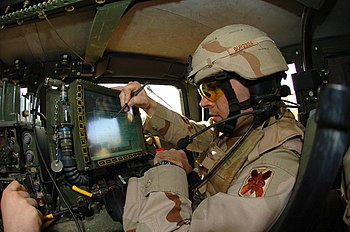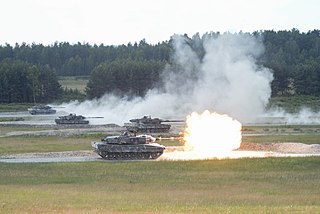Electronic warfare (EW) is any action involving the use of the electromagnetic spectrum or directed energy to control the spectrum, attack an enemy, or impede enemy assaults. The purpose of electronic warfare is to deny the opponent the advantage of, and ensure friendly unimpeded access to, the EM spectrum. EW can be applied from air, sea, land, and/or space by manned and unmanned systems, and can target humans, communication, radar, or other assets.

The Joint Tactical Information Distribution System (JTIDS) is an L band Distributed Time Division Multiple Access (DTDMA) network radio system used by the United States armed forces and their allies to support data communications needs, principally in the air and missile defense community. It produces a spread spectrum signal using Frequency-shift keying (FSK) and Phase-shift keying (PSK) to spread the radiated power over a wider spectrum than normal radio transmissions. This reduces susceptibility to noise, jamming, and interception. In JTIDS Time Division Multiple Access (TDMA), each time interval is divided into time slots. Together, all 1536 time slots in a 12-second interval are called a "frame". Each time slot is "bursted" (transmitted) at several different carrier frequencies sequentially. Within each slot, the phase angle of the transmission burst is varied to provide PSK. Each type of data to be transmitted is assigned a slot or block of slots (channel) to manage information exchanges among user participation groups. In traditional TDMA, the slot frequencies remain fixed from second to second. In JTIDS TDMA, the slot frequencies and/or slot assignments for each channel do not remain fixed from frame to frame but are varied in a pseudo-random manner. The slot assignments, frequencies, and information are all encrypted to provide computer-to-computer connectivity in support of every type of military platform to include Air Force fighters and Navy submarines.
In modern use, the order of battle of an armed force participating in a military operation or campaign shows the hierarchical organization, command structure, strength, disposition of personnel, and equipment of units and formations of the armed force. Various abbreviations are in use, including OOB, O/B, or OB, while ORBAT remains the most common in the United Kingdom. An order of battle should be distinguished from a table of organisation, which is the intended composition of a given unit or formation according to the military doctrine of its armed force. As combat operations develop during a campaign, orders of battle may be revised and altered in response to the military needs and challenges. Also the known details of an order of battle may change during the course of executing the commanders' after action reports and/or other accounting methods as combat assessment is conducted.

ISTAR stands for intelligence, surveillance, target acquisition, and reconnaissance. In its macroscopic sense, ISTAR is a practice that links several battlefield functions together to assist a combat force in employing its sensors and managing the information they gather.
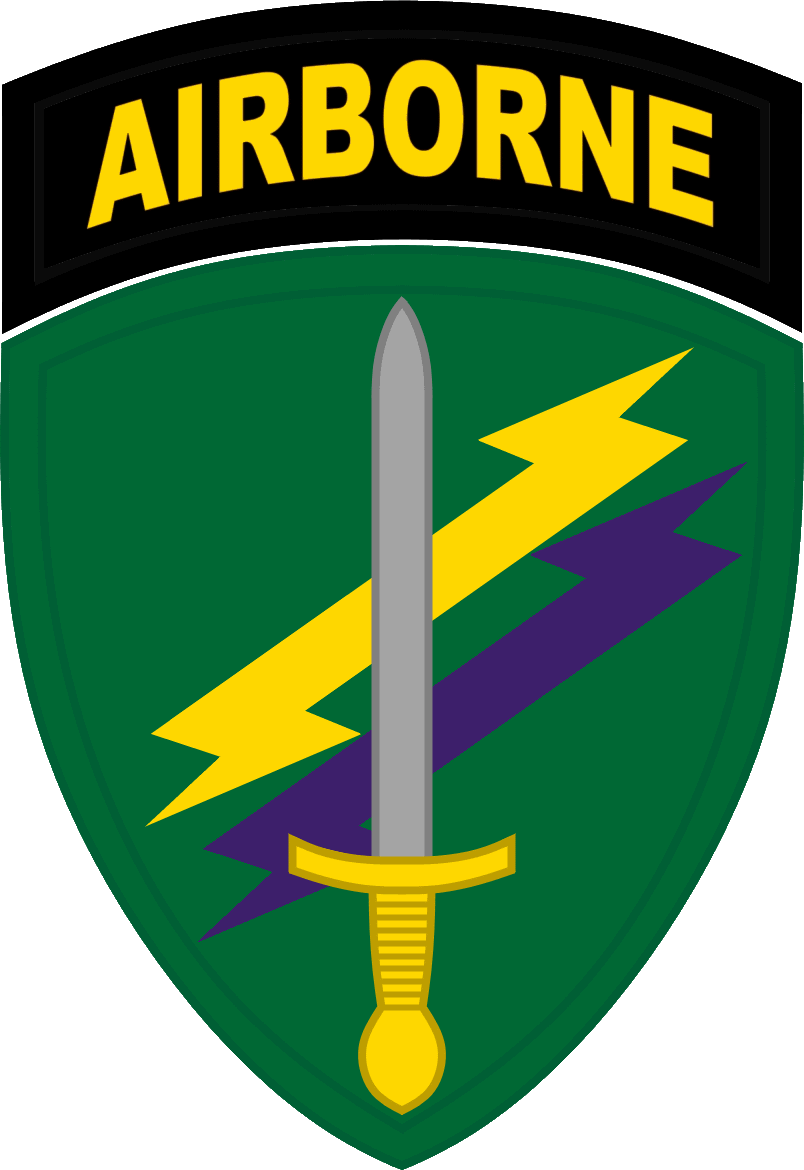
The United States Army Civil Affairs and Psychological Operations Command (Airborne), or USACAPOC(A), was founded in 1985. USACAPOC(A) is composed mostly of U.S. Army Reserve soldiers in units throughout the United States. Its total size is approximately 10,000 soldiers, making up about 94 percent of the DoD's Civil Affairs forces and 71 percent of the DoD's Psychological Operations forces. It is headquartered at Fort Bragg, NC. The current commander is Major General Daniel R. Ammerman, who assumed command in June 2014.
The Army Battle Command System (ABCS) is a digital Command, Control, Communications, Computers and Intelligence (C4I) system for the US Army. It includes a mix of fixed/semi-fixed and mobile networks. It is also designed for interoperability with US and Coalition C4I systems.
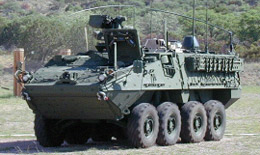
The M1130 Commander Vehicle (CV) is an armored command vehicle based on the Stryker platform. It is used within the brigade to provide means to receive information, analyze and transmit data, and control forces carrying out combat missions.
The American Battlefield Protection Program (ABPP) is a United States federal government program created by the Secretary of the Interior in 1991, with the aim of preserving historic battlefields in the United States. In 1996, Congress signed into law the American Battlefield Protection Act, which officially authorized the ABPP. The program operates under the American Battlefield Protection Program Authorization as of 2009.
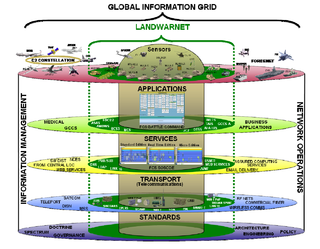
The FCS Network - Brigade Combat Team (BCT) Network consists of five layers that combine to provide seamless delivery of data to forward-deployed Army units.

Special reconnaissance (SR) is conducted by small units of highly trained military personnel, usually from special forces units or military intelligence organizations, who operate behind enemy lines, avoiding direct combat and detection by the enemy. As a role, SR is distinct from commando operations, but both are often carried out by the same units. The SR role frequently includes covert direction of air and missile attacks, in areas deep behind enemy lines, placement of remotely monitored sensors and preparations for other special forces. Like other special forces, SR units may also carry out direct action (DA) and unconventional warfare (UW), including guerrilla operations.
Military swarming is a battlefield tactic designed to maximize target saturation, and thereby overwhelm or saturate the defenses of the principal target or objective. On the other-hand, defenders can overcome attempts at swarming, by launching counter-swarming measures that are designed to neutralize or otherwise repel such attacks.

The Project Manager Force Battle Command Brigade and Below is a component of the Program Executive Office Command Control and Communications Tactical Special Projects Office in the United States Army. The phrase "brigade and below" in the name refers to the fact that operations and communications within these smaller Army units are shifting to a digital integration.

Neil Gilbert Siegel is an American computer scientist, systems engineer, and engineer, known for his development of many key systems for the United States military, including the Blue-Force Tracking system, the US Army's first unmanned air vehicle system, the US Army forward-area air defense system, and many others. Several of his key inventions also found their way into consumer products, such as hand-held devices whose map displays automatically orient themselves to align with the real-world's cardinal points.

Battle command (BC) is the art and science of visualizing, describing, directing, and leading forces in operations against a hostile, thinking, and adaptive enemy. Battle command applies leadership to translate decision into actions, by synchronizing forces and warfighting functions in time, space, and purpose, to accomplish missions. Battle command refers both to processes triggered by commanders and executed by soldiers and to the system of systems (SoS) that directly enables those processes.
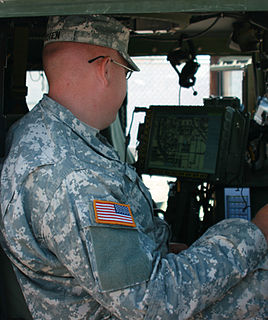
The Army will continue the development and fielding of an incremental ground tactical network capability to all Army brigade combat teams. This network is a layered system of interconnected computers and software, radios, and sensors within the Brigade Combat Team (BCT). The BCT network is essential to enable Unified Battle Command and will be delivered to the Army's Brigade Combat Teams in increasing capability increments. The first increment is currently finishing SDD developmental and operational testing and will be delivered to Infantry Brigade Combat Teams in the form of Network Integration Kits (B-kits) with E-IBCT.

25U - Signal Support Systems Specialist is a military occupational specialty (MOS) in the United States Army Signal Corps. The signal support systems specialist supervises, installs, deploys, maintains, troubleshoots, trains, and assists the General Purpose User with Programs of Record and Commercial off the Shelf communications equipment, as appropriate, within the Tactical Operations Center (TOC), Command Post (CP), and vehicle platforms. This includes information systems support and Army Battle Command System (BCS) ; Communications and Electronic (C&E) equipment ; Communications Security (COMSEC) devices ; and telephone wire, Local Area Networks (LAN) and Routers. Performs field level unit maintenance on authorized Communications systems and COMSEC devices and prepares maintenance and supply requests for field level signal support. Disseminates and enforces signal policies and integrates signal systems and networks with adjacent units. Installs, Operates, and Maintains Radio Retransmission (RETRANS) operations and performs Preventive Maintenance Checks and Services on assigned vehicles and power generators.
Nett Warrior (NW) is an integrated dismounted leader situational awareness (SA) system for use during combat operations of the United States Army.

Nickolas G. "Nick" Justice is a U.S. Army major general who commanded the United States Army Research, Development and Engineering Command and Aberdeen Proving Ground, Maryland.
A battle lab or battle laboratory is a capability enabled by a set of means to analyze or assess impacts that could be induced by changes in a military realm. The changes can be of any kind: equipment, technologies, organization, doctrine or changes in the environment itself.
Photograph taken of Major Stuart Burruss, Executive Officer, 2-156th Infantry, 256th Brigade Combat Team (Mechanized) at Camp Liberty prior to a combat patrol in the brigade's Area of Operations.
